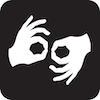Learning a new language can be challenging, and understanding the culture associated with it plays a crucial role.
Norms and regional differences familiar to the native speaker are often elusive to the outsider. Nowhere is this more true than when learning ASL, a language that is neither spoken nor written, and one used exclusively by the deaf community. It is no wonder that mistakes are made in the learning process. Many of these mistakes can be avoided.
After teaching ASL and serving as an ASL interpreter for years, these are the core things I took away.
The hands are faster than the eyes.
Let me explain.
When interpreting from spoken word into ASL, beginning interpreters often make the mistake of trying to keep up with what is being said. They rush along, their hands flying, as they try to keep pace with the speaker. In the process, they forget that the primary responsibility is not to interpret what is being spoken, but rather to communicate what is being expressed. Good interpreting requires interpreters to step into a world of silence. The language that inhabits this world is filled with precise movements, symbols, spaces, and facial expressions. For the most part, ASL does not share its syntax with the spoken word. Its syntax is unique.
OK
Syntax is Tricky; think of a Venn diagram that has two independent circles with some overlapping parts.
ASL has a unique syntax. It shares some syntactical rules with other languages; for example, Chinese incorporates symbols and indicates the tense (past, present, or future) at the beginning of a sentence. American Sign Language was developed in an English-speaking culture and shares some of English's structural elements. That said, it is a mistake to impose the rules of written and spoken English onto this language.
Adjectives, Adverbs, and Tone:
Cadence is modulated by varying time space, and force(or speed), and is done not with voice but with movement, using body positions, facial expression, subtle shifts, and so much more. ASL is a three-dimensional language with space-specific, sign-specific, and facial expression-specific elements, all happening simultaneously, to create a language as complex as it is beautiful.
